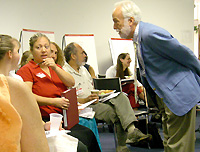Is the grassroots community at your partnership table? February 7, 2011
Posted by tomwolff in : Uncategorized , trackbackI was recently leading a webinar for a new Federal initiative. Their focus is on health issues identified by the community as adversely affecting the health of women and girls. In the first phase of funding they were to spend a year doing a community needs assessment.
One major focus of my presentation was the necessity of engaging those most affected by their issues in all aspects of the project, not just the assessment but also program planning, implementation, and evaluation.
We had a lively exchange on this topic – who were those most affected by the issues they were assessing? Were they already at the partnership table? If not how could they get them there? And how could they keep them there? I also asked what actual roles will those most affected play in the partnership. To answer this last question I use a variation of the Arnstein Ladder of Participation that asks us to rate our level of engagement of the grassroots on a continuum from tokenism and decoration (lowest level) to shared decision making (highest level). (See The Power of Collaborative Solutions page 98-99). This made for a fascinating discussion.
These are all good questions to ask for your own work. These particular projects were very engaged in actively addressing these issues and getting the community to the table.
How would you answer these questions for your own community work?
For me it highlighted once again how much we in community health and development espouse the idea of having the grassroots at the table as equal partners and how seldom we actually practice it.
How often do you sit at a partnership /coalition/collaboration table and actually see a decent number of representatives from what we often call the “target population” or those most affected by the issue? (By the way – how would you like to be called a “target population”?)
How often does any one in your community go door-to-door in your neighborhoods and ask the residents what they see as the issues and what they see as the strengths of their community? And how they can work with us to solve the emerging issues? In my experience this is happening less and less. Why is that? How can we function effectively without doing the above?
I am very concerned that we are not talking with those most affected because it means we can’t possibly truly understand their issues, find the appropriate solutions, get community buy-in to the solutions and finally hope for any community sustainability. All these steps are crucial to successful intervention and all REQUIRE having the community at the table with us.
As community organizers and developers we used to actually be on the streets and in the neighborhoods, what happened?
In one of my next blogs I will talk about four possible solutions,
Do you have the grassroots community at the table for your work? How did you make that happen? How can we all bring the community to the table for shared decision making?
To add a comment Click Here







Comments»
no comments yet - be the first?